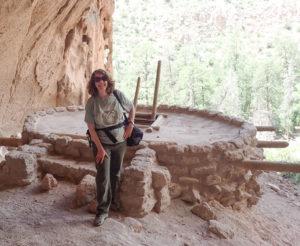During my childhood, I often visited archaeological sites throughout the southwest during summer vacations. Although I was very exited about science (archaeology, geology, astronomy

and biology) like so many girls of my generation, I found myself redirected to a more appropriate venue. I got my degree from CU in fine arts and became an artist and instructor.
When I finally reached the wonderful age of 55, I discovered the Senior Auditors Program at CU. I immediately began to take as many classes as I could manage. In an archaeology class another senior suggested that I should check out IPCAS. I went to a meeting, just to see, not planning to join anything, as I was over committed already and way too busy. I did find the lecture very interesting. When I attempted to make a quiet exit I was diverted by the plate of Oreos on the table. Before I could leave, Tom Cree politely insisted that I sign a guest list and take a newsletter. As my mouth was full of cookies, I couldn’t argue. I was hooked. Newsletters were full of opportunities for field trips, classes, and volunteering on surveys and excavations. In addition, I found I had stumbled into a group of people as motivated by curiosity as I am.
I soon discovered the PAAC program. In 2006 my 1st class was Rock Art. Classes taught by Kevin Black were both entertaining and a great supplement to my CU auditing. This time I got credit. I earned my certifications for PAAC Scholar and Laboratory Trainee.
In 2012 I joined the IPCAS Board as PAAC Coordinator. I have served on the board in several roles since then and am currently CU Liaison.
The really big hook came in 2007. I decided that, if I was going to spend all this time studying archaeology, I should find out if I actually liked hiking around way out in the wilderness looking for mystery stuff on the ground or sitting in the dirt in the summer heat going through someone’s 1000 year old trash. I volunteered for Dr. Doug Bamforth’s CU field school near Chadron, Nebraska. This turned out to be a perfect introduction to hands on real life archaeology. I learned how to excavate, record the data, draw a profile and deal with the dust storm resulting from attempting to screen in a high wind. I was intrigued by the mystery, figuring out ancient lives based on the stuff left behind. I LOVED it!
The next week I was camping near Fairplay, working on a PIT survey. I learned about flint knapping, debitage, lithic scatter, flagging, culturally altered trees and filling out forms. The view was fabulous. The artist in me loved the patterns of tiny gold and red flakes which littered the ground. A few weeks later I was in Hermit Park on a PAAC survey. We walked through forest and clambered over rocky outcrops, eyes to the ground. I can still hear Kevin’s voice as I climbed up a huge rock certain that the best find was just over the ridge, “Don’t die for Archaeology”. I didn’t fall, but I did actually map a nasty tangle of rusty barbed wire.
Many surveys, excavations, field trips, and conferences followed, getting better all the time as I became more knowledgeable and skilled. I have participated in the Site Stewardship program and gone on some great trips. I worked in North Park and Allen’s Park with Dr. Bob Brunswig. I worked on Dave Dove’s sites in Dove Creek and Cortez and more.
Then I discovered Lab. Beginning in January 2012 I was one of several IPCAS members who volunteered with Jakob Sedig, a Ph. D. candidate at CU. Jakob had conducted excavations at Woodrow Ruin, a Mimbres site, since 2011. He had thousands of ceramic shards which needed to be washed, typed, weighed, counted and curated. Fascinating!!! This work continued until Jacob completed his dissertation in 2015. Meanwhile, in 2013, spring semester, Dr. Steve Lekson invited 3 Senior Auditors to enroll in his pottery analysis practicum, which focused on museum collections from the archaeological site of Yellow Jacket. We participated in hands-on laboratory analyses of ceramic artifacts, and learned about the archaeology of the Mesa Verde region. Amazing!
I was worried about an absence of lab work at CU after Jakob left, but in the fall of 2015 Dr. Scott Ortman invited us to participate in ceramic typology for the Pojoaque Heritage Project. It seem there is still plenty to be done in archaeology and IPCAS offers great opportunities.